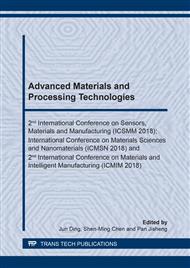[1]
Bruce, W. A., and Keifner, J. (2015). Pipeline Repair Using Full-Encirclement Repair Sleeves. In Winston Reive, R. (Ed.). Oil and Gas Pipelines: Integrity and Safety Handbook. New Jersey: John Wiley & Sons, Inc. pp.635-654.
DOI: 10.1002/9781119019213.ch44
Google Scholar
[2]
Salim, U.S., Valipour, A., Azraai, S.N.A., Lim, K.S., Zardasti, L., Noor, M.N., and Yahaya, N. (2016). Compressive, flexural and tensile properties of graphene modified grouts for pipeline rehabilitation, Malaysian Journal of Civil Engineering, 28-Special Issue (2), 102-111.
Google Scholar
[3]
Li, Y., Li, T. X., Cai, G. W., Yang, L. H. (2013). Influence of AC interference to corrosion of Q235 carbon steel. Corrosion Engineering, Science and Technology, 48(5), 322-326.
DOI: 10.1179/1743278212y.0000000076
Google Scholar
[4]
Othman, S.R., Yahaya, N., Noor, M.N., Lim, K.S., Zardasti, L., and Rashid, A.S.A. (2017). Modelling of external metal loss for corroded buried pipeline. Journal of Pressure Vessel Technology, 139(3), 031702.
DOI: 10.1115/1.4035463
Google Scholar
[5]
Tahir, S.N.F.M.M., Noor, M.N., and Yahaya, N., and Lim, K.S. (2015). Relationship between in-situ measurement of soil parameters and metal loss volume of x70 carbon steel coupon. Asian Journal of Scientific Research, 8(2), 205-211.
DOI: 10.3923/ajsr.2015.205.211
Google Scholar
[6]
Haladuick, S., and Dann, M.R. (2018). Decision making for long-term pipeline system repair or replacement. ASCE-ASME Journal of Risk and Uncertainty in Engineering System, Part A: Civil Engineering, 4(2), 04018009.
DOI: 10.1061/ajrua6.0000956
Google Scholar
[7]
Bernardo, G., Laterza, M., D'Amato, M., Andrisani., G., Diaz, A., and Laguna, E. (2016). ELARCH Project: the use of innovative product based on the nanotechnologies for the protection of architectural heritage. Proceeding of the XII Congresso International Sobre Patologia e Reabilitacao de Estruturas, 26th – 29th October 2016, Portugal.
Google Scholar
[8]
Tahir, S.N.F.M.M., Yahaya, N., Noor, M.N., Lim, K.S., and Rahman, A.A. (2015). Underground corrosion model of steel pipelines using in-situ parameters of soil. Journal of Pressure Vessel Technology, 137(5), 051701.
DOI: 10.1115/1.4028424
Google Scholar
[9]
Pereira, J. C. R., de Jesus, A. M. P., Fernandes, A. A., and Varelis, G. (2016). Monotonic, low-cycle fatigue, and ultralow-cycle fatigue behaviors of the X52, X60, and X65 piping steel grades. Journal of Pressure Vessel Technology, 138(3), 031403.
DOI: 10.1115/1.4032277
Google Scholar
[10]
Shamsuddoha, M., Islam, M.M., Aravinthan, T., Manalo, A., and Lau, K.T. (2013). Effectiveness of using fibre-reinforced polymer composites for underwater steel pipeline repairs. Composite Structures, 100,40-54.
DOI: 10.1016/j.compstruct.2012.12.019
Google Scholar
[11]
Saeed, N., Ronagh, H., and Virk, A. (2014). Composite repair of pipelines, considering the effect of live pressure - Analytical and numerical models with respect to ISO/TS 24817 and ASME PCC-2. Composites: Part B, 58, 605-610.
DOI: 10.1016/j.compositesb.2013.10.035
Google Scholar
[12]
Duell, J.M., Wilson, J.M., and Kessler, M.R. (2008). Analysis of a carbon composite overwrap pipeline repair system. International Journal of Pressure Vessels and Piping, 85, 782-788.
DOI: 10.1016/j.ijpvp.2008.08.001
Google Scholar
[13]
Leong, A.Y.L., Leong, K.H., Tan, Y.C., Liew, P.F.M., Wood, C.D., Tian, W. and Kozielski, K.A. (2011). Overwrap composite repairs of offshore risers at topside and splash zone. Proceedings of 18th International Committee on Composite Materials (ICCM-18). 21st - 26th August 2011. Jeju Island, Korea.
Google Scholar
[14]
Chan, P.H., Tshai, K.Y., Johnson, M., Choo, H.L., Li, S., and Zakaria, K. (2015). Burst strength of carbon fibre reinforced polyethylene strip pipeline repair system – A numerical and experimental approach. Journal of Composite Materials, 49(6), 749-756.
DOI: 10.1177/0021998314525652
Google Scholar
[15]
ASME International. (2011). ASME PCC-2-2011. Repair of Pressure Equipment and Piping. New York, USA: The American Society of Mechanical Engineers.
Google Scholar
[16]
ISO. (2006). ISO/TS 2481. Petroleum, Petrochemical and Natural Gas Industries – Composite Repairs of Pipework – Qualification and Design, Installation, Testing and Inspection. Switzerland: International Organization for Standardization.
DOI: 10.3403/30141798u
Google Scholar
[17]
Farrag, K. (2013). Selection of Pipe Repair Methods. Final Report GTI - Project Number 21087, Gas Technology Institute.
Google Scholar
[18]
Lim, K.S., Azraai, S.N.A., Yahaya, N., Zardasti, L., and Noor, M.N. (2017). Strength development of epoxy grouts for pipeline rehabilitation. Jurnal Teknologi (Science & Engineering), 79(1), 9-14.
DOI: 10.11113/jt.v79.9339
Google Scholar
[19]
Tang, L. C., Wan, Y. J., Yan, D., Pei, Y. B., Zhao, L., Li, Y. B., and Lai, G. Q. (2013). The effect of graphene dispersion on the mechanical properties of graphene/epoxy composites. Carbon, 60, 16-27.
DOI: 10.1016/j.carbon.2013.03.050
Google Scholar
[20]
Ugent Tech Sdn. Bhd. (2014). Graphene Nanoplatelets UG Pro 680 technical data sheet.
Google Scholar
[21]
Antaki, G. A. (2003). Piping and Pipeline Engineering: Design, Construction, Maintenance, Integrity, and Repair. Marcel Dekker, Inc., New York, U.S.A.
DOI: 10.1201/9780203911150.fmatt
Google Scholar
[22]
Liu, H. (2003). Pipeline Engineering. Lewis Publishers, New York, U.S.A.
Google Scholar
[23]
Chatterjee, S., Nafazarefi, F., Tai, N.H., Schlagenhauf, L., and Chu, B.T.T. (2012). Size and synergy effects of nanofiller hybrids including graphene nanoplatelets and carbon nanotubes in mechanical properties of epoxy composites. Carbon, 50, 5380-5386.
DOI: 10.1016/j.carbon.2012.07.021
Google Scholar


